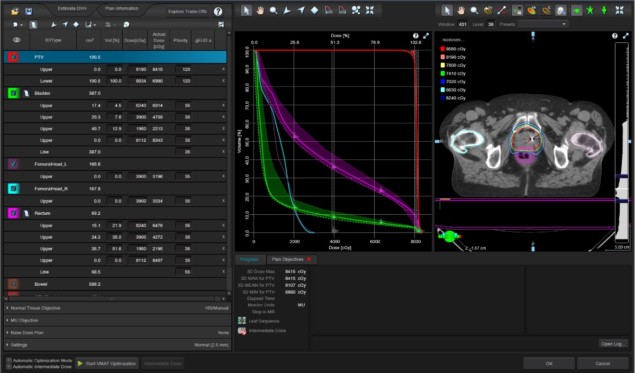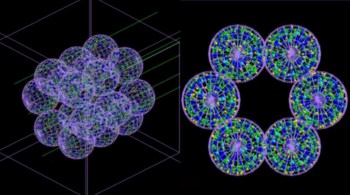
Automated radiotherapy planning is a boon for medical physicists and dosimetrists, radiotherapy departments, and patients themselves – according to a team at Cone Health Cancer Center. A customized, automated planning model can reduce the preparation time of a patient’s treatment plan, decrease plan variation and improve healthy tissue sparing compared with manual planning.
Since 2015, dosimetrists and medical physicists at this community cancer treatment centre have used Varian’s RapidPlan, a commercial knowledge-based planning predictive model that generates estimated dose–volume histograms (DVHs) based on previous patient anatomy and dose distributions for use in the Eclipse treatment planning system. The team has now demonstrated that using RapidPlan with a customized automated planning model to develop volumetric-modulated arc therapy (VMAT) plans for prostate cancer patients reduced the average planning time from two hours down to 20 minutes.
With the exception of the maximum dose to the target, all planning target volume (PTV) metrics were dosimetrically similar between auto-generated plans and manual plans. Most importantly for patients, auto-generated plans conferred significantly improved rectal sparing (J. Appl. Clin. Med. Phys. 10.1002/acm2.12674).
“The creation of VMAT plans is still an intricate and time-consuming process due to complexity of treatment, anatomical deviation and level of planner expertise,” write the authors.
The planning software is based on shared knowledge representing clinical practice in leading treatment facilities. It takes into account each patient’s anatomy and planning goals, adjusts the estimated DVH, and provides optimization objectives based on treatment criteria for each individual patient. The software calculates acceptable clinical trade-offs for target coverage and dose to organs-at-risk (OARs).
Customized models can be created from the baseline models. Medical dosimetrist and lead author Christopher Amaloo took approximately a week to develop an effective RapidPlan model that uses plans from previously treated patients. This model was then applied with a totally automated system customized to the radiation oncology department’s protocols using Varian’s Eclipse Scripting Application Programming Interface (ESAPI), developed by medical physicist Lane Hayes.

“The Eclipse Scripting API is basically a set of programming tools that directly replace button clicks a person would perform in the Eclipse planning system,” Hayes told Physics World. “We developed and tested a logical framework over a several week period so that it would emulate the decision-making process of a planner setting up a new prostate treatment plan. Then a customized RapidPlan model is applied automatically at the end of the process to generate a patient’s customized treatment plan that is clinically acceptable.”
This model has been in use for one year to treat an estimated 100 prostate cancer patients with VMAT. “The combination of RapidPlan and ESAPI linked the plan creation to optimization through final calculation in a way that is more valuable and practically beneficial for our treatment planners,” explains Hayes. “While using the predictive model alone was comparable to manual treatment planning, the combination saves a tremendous amount of time for our planners.”
Plan comparisons
For their study, the researchers created manual and auto-generated VMAT plans for 20 prostate cancer patients prescribed 78 Gy in 40 fractions. For all patients, both plans met departmental guidelines for OAR sparing and minimal target coverage.
A team of eight dosimetrists, medical physicists and radiation oncologists independently blind-reviewed and compared each of the 20 paired test cases to determine suitability of the plans. For each case, they selected a preferred plan. For 18 of 20 cases, the majority of reviewers preferred the auto-generated plans or had no preference.
The auto-generated plans increased sparing within the rectal volume, while the manual plans reduced the bladder maximum dose, though neither plan provided consistently improved results. “While sparing of all OARs is important, the relative value of the bladder increase compared to the rectal sparing is regarded as an acceptable compromise,” the authors write.
The researchers note that the automated planning process, consisting of simple data entry and a singular button click, transforms an arduous manual process to one that is essentially resource-free. The automated approach reduces active planning time to under five minutes on average and the total planning time to 20 minutes, including optimization and calculation time.
“From a physician’s perspective, we have gained high reliability of plan quality, independent of the specific planner. This is helpful when team members have shifted coverage and roles,” says Hayes. “From the perspective of a medical physicist, these plans are more compliant with guidelines and naming conventions, and are typically completed with more lead time regarding the first treatment.”
Although the radiation oncology department has not changed staffing size, the time savings have helped shift the dosimetry team’s focus to more challenging and unique cases. For a busy community cancer treatment centre, this auto-generated planning model for VMAT has become invaluable.



